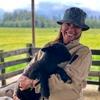Canavalia ensiformis for parasite control
Effect of the Intake of Jackbean (Canavalia Ensiformis) on the Control of Gastrointestinal Parasites and the Growth of Tropical Lambs
Published: September 27, 2011
Source : Leyla Ríos-de Álvarez (Universidad Central de Venezuela), John F. Huntley, Frank Jackson (Moredun Research Institute),Francisco Cortez (Universidad Central de Venezuela), George Grant (The Rowett Institute of Nutrition and Health), Andrew Greer (Linc
INTRODUCTION
Many tropical forages harbour anti-parasitic properties which may assist in the development of a cost-effective method of parasite control for resource poor farmers.
In particular, Canavalia ensiformis (jackbean) contains high levels of lectins, the purified form of which have been demonstrated in both in vitro and in vivo to have anthelmintic properties.
This study investigated the effect of supplementation with canavalia seed on the performance and parasite status of West African male lambs that were naturally infected and maintained under foraging conditions.
AIM
To evaluate the possible anthelmintic effect of Canavalia ensiformis seeds on natural parasitism of foraging West African lamb, under tropical conditions
MATERIALS AND METHODS
Twenty West African male lambs that were naturally infected and maintained under foraging conditions in Venezuela were allocated to one of two treatments (n=10) for eleven weeks.
Treatments consisted of either a supplement of brewers grain at 2% of bodyweight of each morning (group C-) or the same supplement which also included 2g per kgLW canavalia[Canavalia ensiformis] seed (group C+).
All animals continued to graze native forages and star grass [Cynodon nlemfluensis] during the day.
Animal live weight was recorded weekly in addition to the collection of faecal samples for the determination of the concentration of nematode eggs and oocysts in the faeces.
RESULTS
Canavalia supplementation increased liveweight gains from -10 ± 9.2 g per d for C- animals to +21 ± 8.2 g per d for C+ animals (P=0.02), resulting in a 2.2 kg advantage in live weight in canavalia supplemented animals by the conclusion of the study.
Canavalia supplementation resulted in an overall reduction in the concentration of nematode eggs and oocytes in the faeces, with mean back-transformed values being 2020 and 1370 nematode eggs per g (P=0.002), and 2170 and 1430 oocytes per g (P=0.05) for C- and C+ groups, respectively.

Figure 1. Liveweight of the lambs during the experiment that were grazing naturally infected pastures while supplemented with canavalia (C+) or not (C-).

Week of infection
Figure 2. Concentration of nematode eggs in the faeces of animals supplemented with canavalia (C+) or not (C-).
CONCLUSION
Dosing with canavalia seed at this level provided a significant increase in animal performance that was associated with a reduction in the parasite status of the animals with no apparent adverse effects on the animals.
ACKNOWLEDGEMENTS
- To the staff from the Laboratorio-Sección de Ovinos, Facultad de Agronomía-Universidad Central de Venezuela, for the support during the experiment.
- For the financial support to assist to the WAAVP 2011: Postgrado de Producción Animal-UCV, Rectorado de la UCV, Decanato de Facultad de Agronomía-UCV and FONACIT.
This poster has been presented at the 23rd International Conference of the World Association for the Advancement of Veterinary Parasitology (WAAVP ), 21-25 August 2011 Buenos Aires, Argentina. Engormix.com thanks the authors and the organizing committee for this contribution.
Related topics:
Mentioned in this news release:

Recommend
Comment
Share
Livestock Management Department
16 de octubre de 2011
It is a good information for raising animals for the purpose of meat production in the remote rural areas. The variety of plants available in the pastures need appropriate documentation for nutrient value and pharmaceutical properties. The significant of effect of this herb on weight gain and parasitic control offers it as a potential candidate for feed supplementation at small farmers' level. Congratulations to the author.
Recommend
Reply

1 de noviembre de 2011
Hello Vasco. Thanks for writing. Yes for sure Canavalia ensiformis and other species of Canavalia are available in the tropics worldwide. I have checked that is used in Pakistan, for sure in other tropial countries also.
Kind regards,
Recommend
Reply

19 de octubre de 2011
it is a good natural anthelmantic being used for small ruminants.Is it available in other parts of the world? Congratulations
Recommend
Reply

16 de octubre de 2011
Many Thanks Dr Subhan Qureshi. Very happy if our tropical results, coming from the other side of the world, are useful in your conditions also.
Regards,
Leyla
Recommend
Reply

3 de octubre de 2011
Dear Dr Shafique:
Thanks for writing. We are very happy to have some effect with the seed meal on bot nematodes and Eimeria, and now for the next experiment we will try the lectin Con A extracted from the seeds. So we can really know if the effect is due to the lectin, and hoping to find a stronger effect. Through a very quick search using google I found that yes you do have the legominous Canavalia at Paquistan (see link: http://www.efloras.org/florataxon.aspx?flora_id=5&taxon_id=250065270) . Its a very big white bean, the plant is a medium size one (aprox. 1 m tall) with beautiful purple flowers.
Ragards,
Leyla
Recommend
Reply
.jpg&w=3840&q=75)

Diets of Productive Sheep & Goats: Performances & Health - Dr. Cannas, University of Sassari
Suggested link
3 de octubre de 2011
it is a good natural anthelmantic being used for small ruminants.Is it available in other parts of the world or in Pakistan?
Recommend
Reply

Would you like to discuss another topic? Create a new post to engage with experts in the community.












